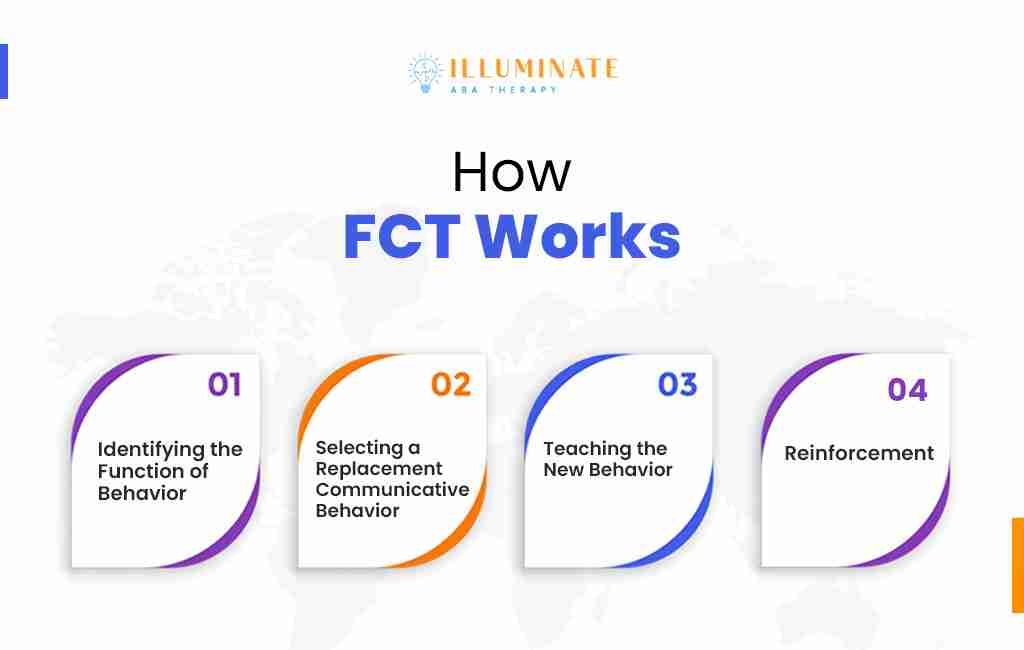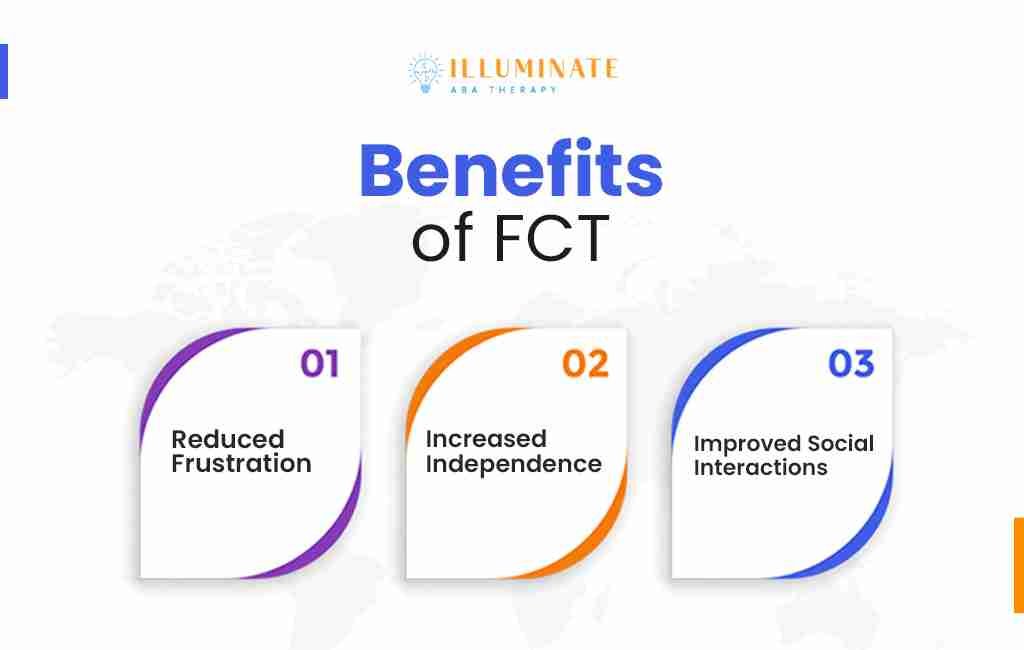The Power of Functional Communication Training (FCT)
ABA TherapyJuly 17, 2025

Functional Communication Training (FCT) is a pivotal intervention in the realm of Applied Behavior Analysis (ABA) therapy, designed to enhance communication skills in individuals, particularly those with autism and other developmental disorders.
This blog will explore the definition, implementation, and benefits of FCT, along with addressing common challenges and the role of parents and caregivers.
Table of Contents
Introduction to FCT
Functional Communication Training (FCT) is defined as a behaviorally-based procedure aimed at increasing effective communication while reducing inappropriate or challenging behaviors that are not effective. Originating from the field of behavior analysis, FCT was developed to address communication deficits that often lead to disruptive behaviors.
By teaching individuals alternative communication methods, FCT significantly improves their ability to express needs and desires, thereby enhancing their overall quality of life.
FCT is crucial in improving communication skills and reducing maladaptive behaviors. It recognizes that many challenging behaviors serve as a form of communication for individuals who struggle with traditional methods. By providing functional alternatives, FCT helps reduce frustration and anxiety associated with communication difficulties.
Understanding Communication Challenges
Individuals with autism and other developmental disorders often face significant communication challenges that can profoundly impact their daily lives. These challenges can manifest in various ways, including tantrums, aggression, or frustration when they are unable to effectively express their needs, desires, or emotions.
One common scenario is a child with autism throwing a tantrum to escape an uncomfortable situation or to gain access to a preferred item. For instance, a child might become overwhelmed in a crowded, noisy environment and lash out aggressively to communicate their distress. Alternatively, a child might engage in disruptive behaviors to request a toy or snack they want.
These maladaptive behaviors serve as a form of communication for individuals who lack the necessary skills to express themselves through more appropriate channels. They highlight the urgent need for effective communication strategies that can replace problematic responses with functional, socially acceptable forms of expression.
By understanding the underlying communication challenges faced by individuals with autism and other developmental disorders, we can better appreciate the importance of interventions like Functional Communication Training (FCT) in addressing these issues and improving overall quality of life.
How FCT Works
The fundamental principles behind FCT involve understanding the function of challenging behaviors and teaching alternative communicative responses. The process typically follows these steps:

- Identifying the Function of Behavior: Conducting a Functional Behavioral Assessment (FBA) helps determine why a behavior occurs.
- Selecting a Replacement Communicative Behavior: Based on the FBA results, therapists identify an appropriate alternative behavior that serves the same function as the problematic behavior.
- Teaching the New Behavior: The selected communicative response is taught using various methods such as verbal communication, gestures, or picture exchange systems.
- Reinforcement: Positive reinforcement is provided when the individual uses the new behavior effectively, encouraging its continued use and reducing reliance on maladaptive behaviors.
Implementing FCT
To successfully implement FCT, practitioners should follow specific guidelines:
- Conducting a Functional Behavior Assessment (FBA): This assessment identifies the purpose behind problematic behaviors.
- Selecting Appropriate Communication Forms: Depending on the individual's abilities, suitable forms of communication may include verbal language, sign language, gestures, or augmentative and alternative communication (AAC) devices.
- Example Scenarios: Case studies illustrate how FCT can be applied in various settings such as home, school, or therapy environments, demonstrating its versatility and effectiveness.
Benefits of FCT
FCT offers numerous benefits for individuals with communication difficulties:

- Reduced Frustration: By equipping individuals with effective communication tools, FCT minimizes feelings of frustration associated with unmet needs.
- Increased Independence: Individuals learn to express their desires independently, fostering a sense of autonomy.
- Improved Social Interactions: Enhanced communication skills lead to better social engagement and interactions with peers and caregivers.
Research supports the effectiveness of FCT; studies have shown significant reductions in problem behaviors among individuals undergoing this training compared to those receiving standard treatments.
Challenges and Considerations
While Functional Communication Training (FCT) offers significant benefits for individuals with communication challenges, several hurdles can complicate its implementation.
Recognizing and addressing these challenges is crucial for maximizing the effectiveness of FCT. While implementing FCT can be highly beneficial, several challenges may arise:
Consistency
One of the primary challenges in implementing FCT is ensuring consistent application of techniques across various settings. Individuals often receive support from multiple caregivers, educators, and therapists, each of whom may have different approaches to communication training.
This inconsistency can lead to confusion for the individual, making it difficult for them to learn and generalize new skills effectively. For instance, if a child is taught to use a picture exchange system at school but is not encouraged to do so at home, they may struggle to apply this skill in different environments.
To combat this challenge, practitioners must prioritize treatment fidelity. This involves adhering closely to the established FCT protocols and ensuring that all team members are on the same page regarding strategies and expectations. Regular communication between parents, therapists, and educators can help create a unified approach that reinforces learning across all settings.
Generalization
Another significant challenge is generalization—the ability for an individual to apply learned behaviors in various contexts outside of therapy sessions. For example, a child might successfully use a new communication method with their therapist but fail to use it when interacting with peers or family members. This inconsistency can stem from a lack of practice in real-life situations or insufficient reinforcement when the child attempts to use their new skills outside of structured environments.
To facilitate generalization, practitioners should incorporate strategies that encourage practice in natural settings. This might include role-playing scenarios during therapy that mimic real-life situations or involving family members in practice sessions. By providing opportunities for individuals to use their communication skills in diverse contexts, they are more likely to retain and apply these skills in everyday interactions.
Role of Parents and Caregivers
Parents and caregivers play an essential role in the success of FCT. Their active involvement not only reinforces the skills learned during therapy but also enhances learning opportunities at home. When parents are engaged in the process, they can create a supportive environment that encourages effective communication.

Strategies for Parents
- Reinforcing New Communicative Behaviors: Parents should actively reinforce any attempts their child makes to use new communicative behaviors. Positive reinforcement—such as praise, rewards, or additional attention—can motivate children to continue using these skills. For instance, if a child uses a sign or picture card to request a snack instead of throwing a tantrum, immediate praise can reinforce this positive behavior.
- Creating Opportunities for Practice: Parents can integrate communication practice into daily routines by creating situations where their child can use their new skills. For example, during mealtime, parents might encourage their child to request items using their preferred communication method (e.g., verbal requests or picture exchange). By embedding these practices into everyday activities, parents help solidify the child's learning and increase confidence in using their communication skills.
Resources and Training Options
To empower parents and caregivers in supporting their child's communication development effectively, numerous resources and training options are available. Workshops led by speech-language pathologists or behavior analysts can provide valuable insights into FCT techniques and strategies for implementation at home. Additionally, online resources such as videos, articles, and support groups can offer ongoing education and community support.
By equipping parents with the knowledge and tools necessary for successful implementation of FCT, we enhance the overall efficacy of the program and promote better outcomes for individuals with communication challenges. Ultimately, a collaborative approach between professionals and families is vital for fostering effective communication skills that lead to improved quality of life.
Conclusion
Functional Communication Training is a powerful intervention that addresses communication challenges faced by individuals with autism and other developmental disorders. By replacing maladaptive behaviors with functional communication strategies, FCT not only enhances individual autonomy but also improves social interactions.
Parents and professionals are encouraged to consider FCT as a viable strategy for fostering effective communication skills. For those interested in implementing FCT or seeking further guidance, numerous resources are available to support this essential training approach.
Read About: Autism-Friendly Activities in Michigan
